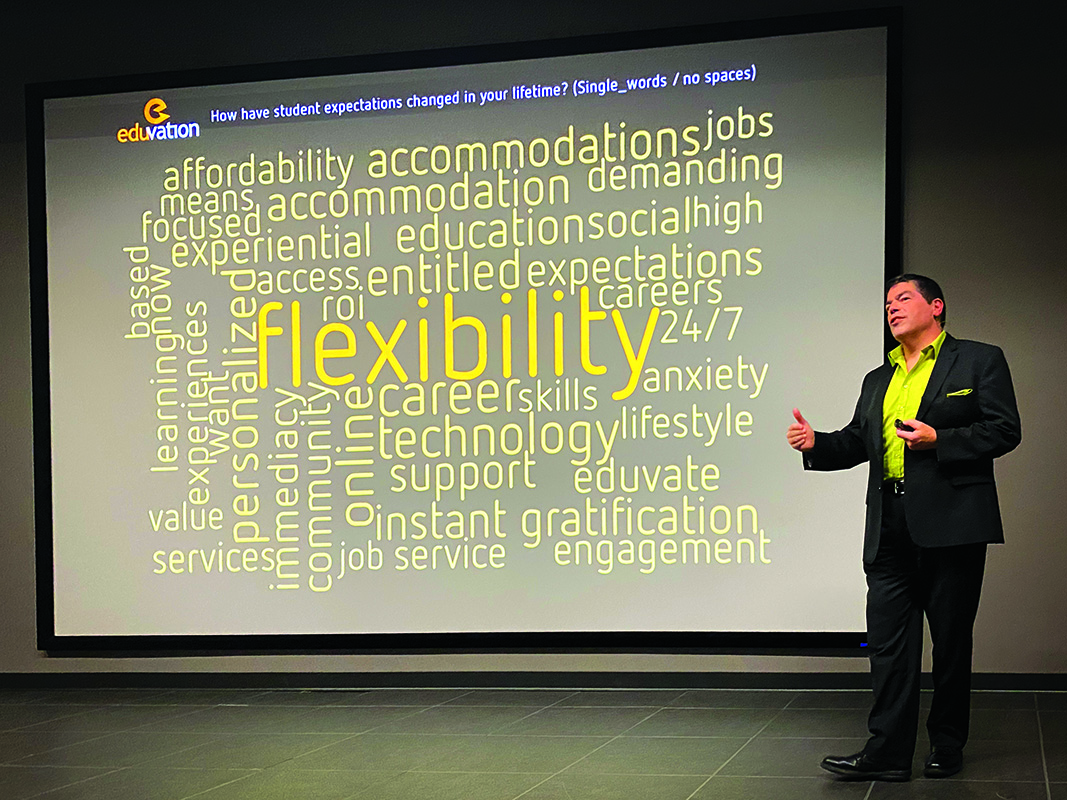UFV faculty, staff, and students packed into the Building B auditorium on Friday, Nov. 15 to hear a lecture by Ken Steele on the future of higher education.
Steele is the founder of Eduvation, a market research think-tank that specializes in helping post-secondary schools adapt to changing conditions within higher education in the present and near future. He hosts a weekly webcast called “Ten with Ken,” which covers various aspects of the future of education.
Steele was introduced by James Mandigo, vice president academic. The lecture is part of Mandigo’s short-term projects for UFV administration, which were laid out at October’s UFV town hall meeting. Present and future trends in education will affect UFV’s longer-term planning.
Steele identified nine core areas where post-secondary education is experiencing or will soon experience major disruptions. The lecture was jam-packed with facts and information, and it would be difficult to do justice to each aspect, but a few core themes emerged over the course of the presentation.
Advances in industry, science, and digital technology are changing the world of universities as much as anywhere else. Technology can be both a boon and a threat. Increases in automation puts the future careers of students in doubt as artificial intelligence (A.I.) improves. Yet this same A.I. can also help students learn. For example, an A.I. program disguised as a fellow student named Jill Watson helped answer students’ questions in an online course forum in the U.S., and was convincing enough that Watson was able to pass as a human to most of the students.
One of the biggest changes facing universities is the increasing diversity of the student body. Immigration is making up an increasing proportion of population growth within Canada, not so much due to increasing immigration, but because of a falling birthrate at home. Services for new Canadians and international students are becoming more important.
A poll of the audience, answered using their phones, revealed that most consider providing services for international students and new Canadians to be a high priority.
Another area in which diversity plays a role is indigenization. Post-secondary schools seek to reduce the barriers to education for many First Nations people by appointing Indigenous recruiters and counsellors, and providing separate queues to fast track enrollment for Indigenous students. In addition, many universities are finding ways to incorporate Indigenous learning into their standard courses.
Colleges and universities are also becoming more diverse in age, physical and mental ability, and the preferred learning style of students. An increasing number of students also identify as disabled, with a growing proportion of these having mental rather than physical disabilities, which increases the demand for mental health services and disability accommodations on campus.
In addition to physical and mental challenges, students often have to juggle the responsibilities of a job or family. To cater to these varied needs, universities have been moving away from the traditional single lecturer model of instruction that does not work well for some students, and incorporating more technology and experiential learning opportunities into the classroom.
To accommodate students with scheduling restrictions and different learning styles, many universities are experimenting with alternatives to the traditional semester/trimester nine-to-five type of schedule. For example, the Hyflex system allows students the option of in-person classes, online learning, or a hybrid of the two, and students can switch between models on a weekly basis.
Steele believes employers and educators ought to, and will, focus more on specific competencies achieved within classes as opposed to fulfilling broad program requirements. This would allow more flexibility for students and allow them to focus on their areas of interest and strength.
“It’s all about fluidity going forward,” Steele said.
Image: UFV Flickr


